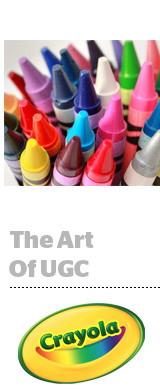
At Crayola, the lines between paid and earned are blurring.
“The interaction between friends and family is so valuable – and it just can’t be garnered from paid media,” said Marisa Scurato, who oversees the brand’s strategic digital marketing efforts. “But we do believe that those things go hand in hand.”
Crayola consumers create a lot of organic content using Crayola products. A search for the #crayola hashtag on Instagram surfaces everything from intricate fan-made “Crayoligraphy” handwriting art to crayon doodles from kids.
The brand’s social team makes good use of those assets by engaging with creators in the comments and republishing their posts.
But the paid media team also wanted to take advantage of the content’s authenticity, which led it to Vivoom, a platform that allows people to use their phone or computer to create and share videos with branded templates and augmented reality filters.
Crayola tested the technology over two weeks in December as part of a larger holiday campaign, encouraging consumers to make holiday video cards and post them across social channels. The purpose was to see if consumers would generate quality video content that Crayola could later repurpose for other campaigns, including paid efforts.
During the test’s limited run, users only created a few hundred videos – but they garnered more than 300,000 views, with a 62% completion rate compared with the 52% average completion rate normally seen on Crayola’s video content. The $.04 cost-per-view rate was also far below the industry benchmark range of $.10 to $.30.
The results are proof that friend-to-friend and user-to-user engagement help performance, Scurato said. Crayola plans to tap its fans to power future content-driven initiatives, including online video campaigns.
“Authentic brand interactions will shape our content plans for 2018,” Scurato said. “It’s definitely the wave of the future.”
In the future, brands further experiment with new ways to reach consumers beyond “traditional interruptive advertising,” said Vivoom CEO Katherine Hays.
At the same time, brands and publishers find themselves less welcome within the distribution channels they’ve come to rely on. A change to Facebook’s algorithm in January means that the news feed now favors posts from friends and family over those coming from brand and publisher pages.
But advertisers are less susceptible to algorithm changes, banner blindness or annoying in-your-face ads that crush the experience when it’s consumers who are voluntarily creating branded content and sharing it with their friends and family.
“Brands can’t just buy audiences anymore – they’ve got to figure out how to be at the top of the feed and make sharing an integral part of the product experience,” Hays said. “Forward-thinking brands like Crayola realize that getting good at consumer-generated advertising is going to give them a significant competitive advantage.”
This post was syndicated from Ad Exchanger.

More Stories
Fox News Leads All News Outlets in YouTube Views for 1st Quarter of 2025
For Most Brands, Tariffs Are Scary. American Giant Sees a Marketing Opportunity
Trump’s Tariffs Will Make AI Costs Soar, But Adoption Won’t Slow